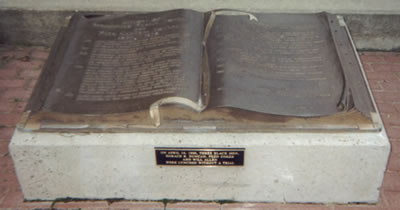I wrote a piece for the Philadelphia Metro. It was about a plaque that was being dedicated at Park Central Square in Springfield Missouri. That plaque read, “On April 4, 1906, Three Black Men, Horace B. Duncan, Fred Coker and Will Allen were were lynched without trial.
There is a plaque in Missouri. A plaque with a few terse words on it. That is what their lives were worth. I speak of three murdered men. I speak of a town full of African Americans forced to take to the trails and woods like fugitives. I speak of nearly 5,000 documented dead, but far more who just disappeared and were never seen by their friends or children or parents again. A plaque.
The plaque, according to Denny Wayne, a city council member in Springfield Mo., says that three men were lynched without trial. The words are neat and economical. Compared to the event, they are almost a comfort. It was dedicated Saturday.
In 1906, Horace B. Duncan, Fred Coker and Will Allen were pulled from their jail cells and dragged to the town square. They were black men accused of having raped a white woman, so their fates were sealed.
Duncan, Coker and Allen were lynched. Hung from a tree in front of a mob of 7,000 citizens of Springfield. They were burned and then dismembered. Women and children were there. People who called themselves men were there. They all watched.
In the following hours, most of the Black citizens of Springfield were driven from their homes by that same mob. Most never returned. That plaque, in its economy, doesn’t mention that.
It also doesn’t mention the 4,743 documented lynchings in the United States between 1882 and 1968. Three quarters involved African Americans. At least a portion, 61 just betwen 1889 and 1918, were women. Women like Laura Nelson, who was hung from a bridge over the Canadian River in Oklahoma with her son. She had been accused of killing a deputy sheriff. Her son had been suspected of no greater guilt than having her for his mother.An exhibit has brought the ugly truth of lynchings back to the fore of the American psyche. The exhibit, entitled “Without Sanctuary” is on display at the Martin Luther King National Historic Site in Atlanta, Ga.. It casts an unflinching eye upon this dark aspect of Americana. It is not easy to look at. Hanging is a grisly way to die.
More chilling are the spectators. They weren’t miscreants or criminals. They were just people. Mothers and fathers packed picnic baskets. In some cases, people lined up to take pictures with the corpses. It was not uncommon for the spectators to take “souvenirs” from the victims, nor were postcards unheard of.
It would be naive to think that all of those eager accessories to those horrendous crimes are now dead and gone. Yet calls for justice are seldom heard. In a country where a formal apology for slavery has yet to be offered to its own African American citizens, I don’t have much hope.
It is far too late for justice for Duncan or Coker or Allen, or Miss Nelson or her son. For now, they and the others whose lives were taken by angry mobs and a thick rope will have to be content with a plaque in Springfield, Mo. A plaque that doesn’t name any names or place any blame. One that says, simply, that three were lynched without trial.
And though it may not be much in the face of such horror, few communities are willing to acknowledge even that.
That piece was written in 2002. I recently found out that the plaque did, indeed, list the names of the victims. And it’s small. So small that when the writer of blog, KenyaSpeaks, visited the site to see the plaque, nobody could tell her where it was. That includes site security.
It is pictured below. Please note, the book is not part of the memorial. It is a document which depicts the town history. The plaque, which is about the size of an envelope, is on the front of the stone.
By the way, lynchings are still a thing. In 2010, a young Black Wesley College student was found hanging from two belts, linked together, from a tree in Dover Delaware. His name was Charles Conley. Local police called it a suicide, despite the fact that there was no suicide note, nor any indication to believe that he was suicidal. Then came John Clark, who was found hanging from his belt less than a quarter mile from Conley, in 2012.
In 2011, leaflets were found in downtown Dover. They depicted of a man hanging from a tree along with a Nazi swastika and the statement, “CLEANING UP THE STREETS, ONE NIGGER AT A TIME.” You can read more about what is taking place in Dover De, here.
Also in 2011, a man named Frederick Jermaine Carter was found hanging, lifeless, from a tree in Tennessee. And in August, a Kenyan man named was found hanging from a tree in New Jersey (I couldn’t find his name). His hands were bound behind his back. It was ruled a suicide.
I suspect I’m only scratching the surface. That’s fine with me.
Click here to find out why I don’t use the word Nigger. (I object to the N’ word as well.) And click here to find out how some lawmen are going all retro on us, and bringing back the posse.
